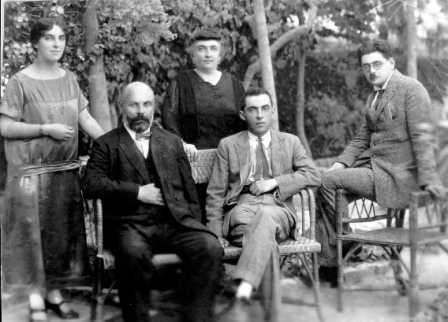
A book about the Ussishkin family was recently published by David Ussishkin, a professor of archaeology at Tel Aviv University and the grandson of the Zionist leader Menachem Ussishkin. David Ussishkin writes in the introduction to the book that the reason he wished to record the family history is so that his grandchildren would know their past. At the moment they are still too young to take an interest in the family history, but when they grow up and wish to know more, they will be able to turn to the book and find all the information in it. Of course, David Ussishkin dedicates the book to his grandchildren.
The CZA holds a large amount of material regarding Menachem Ussishkin and his family. The grandson's book is a fascinating example of the great benefit that can come out of cooperation between an archive and a family who wishes to investigate its roots. The book includes many references to documents that are kept at the CZA – official and private letters that Menachem Ussishkin sent and received.
Menachem Ussishkin was born in 1863 in Dobrovno – a town in Belarus. He was the head of Hovevei Zion, active in the Zionist Congresses, founded various institutions of the Zionist movement and was the head of the Jewish National Fund. In 1919, Menachem Ussishkin left Russia permanently and came to Palestine with his family. He chose to live in Jerusalem, and built a house in Rehavia – on Ussishkin Street of today.
In his book, David Ussishkin refutes the urban legend regarding the name of the street. There are those who claim that the street on which Menachem Ussishkin built his house, was originally called “Rabbi Yehuda Halevi Street”, and that Ussishkin changed its name so it would be named after him. David Ussishkin writes that according to the original plan of the neighborhood (which is to found in the files of the CZA), the name of the street was to be “HaKeren HaKayemet Street” (“the Jewish National Fund Street”), and that the name of the street changed when Menachem Ussishkin turned 70 years old.
Menachem and Esther Ussishkin had two children: Rachel and Shmuel. In 1923 Rachel Ussishkin married Shimon Fritz Bodenheimer, who was the son of another prominent Zionist leader – Max Bodenheimer. This was looked upon as a “royal wedding" between two well-known Zionist families, and indeed, many famous guests were invited. The High Commissioner of Palestine, Herbert Samuel, and his wife attended the wedding, and the chuppah, the wedding ceremony, was conducted by the two chief rabbis of Palestine: the Ashkenazi Rabbi Kook and the Sephardi Rabbi Ya’akov Meir. At the end of the wedding the band played Mendelssohn’s "Wedding March", the British anthem and “Hatikvah”.
The grandson, David Ussishkin, was born in 1935 to Shmuel and Elze Ussishkin. Menachem Ussishkin died when his grandchild was six. David describes his childhood in Rehavia as a quiet and pleasant period. There were only a few cars on the streets, no traffic lights and no public phones, so David and his friends could play ball in the streets with no interruptions. During the Mandate period, the elite of Jerusalem were concentrated in Rehavia: Zionist leaders, professors at the Hebrew University and immigrants from Germany. But the peace in the neighborhood didn’t last long. After the Second World War ended, the struggle against the British began and interrupted life in Jerusalem. After the Israeli Declaration of Independence the situation became even harder because of the siege on Jerusalem. It was difficult to obtain food and water. As the front line was at the Old City, the Ussishkin family heard the noise of the explosions of cannon shells and shooting in their house. David Ussishkin ends his story after the armistice agreements with Jordan, when life in Jerusalem, and in the neighborhood of Rehavia, began returning to normal.